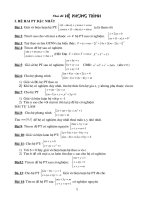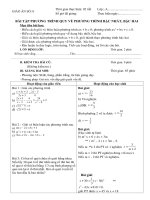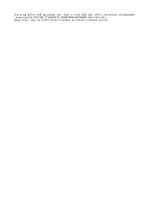Phương trình Diophantine
Bạn đang xem bản rút gọn của tài liệu. Xem và tải ngay bản đầy đủ của tài liệu tại đây (51.21 KB, 2 trang )
<span class='text_page_counter'>(1)</span><div class='page_container' data-page=1>
Diophantine Equations
Alison Miller
June 11, 2010
1
Useful Facts
• Everything from Handout 1.
• Sums of squares.
• Sandwiching: e.g. if you want to prove that some expression X cannot be a perfect kth
power, show that nk <sub>< X < n</sub>k+1 <sub>for some n. This method generalizes.</sub>
• Pythagorean triples.
• Pell’s equation/recurrences/infinite descent
• If you’re looking to construct a solution, try clever algebraic substitutions.
• Don’t be afraid to use the quadratic formula!
• Quadratic Reciprocity
• Look beyond Z: factorizations in Z[i] and Z[ω].
1 (IMO 1982). Prove that if n is a positive integer such that the equation
x3− 3xy2<sub>+ y</sub>3 <sub>= n</sub>
has a solution in integers x, y, then it has at least three such solutions. Show that the equation
has no solutions in integers for n = 2891.
2 (Crux). Prove that the product of five consecutive integers is never a perfect square.
3 (IMO 1996). The positive integers a and b are such that the numbers 15a + 16b and 16a − 15b
are both squares of positive integers. What is the least possible value that can be taken on by the
smaller of these two squares?
4 (IMO Shortlist 2002). Let P be a cubic polynomial given by P (x) = ax3+ bx2+ cx + d, where
a, b, c, d are integers and a 6= 0. Suppose that xP (x) = yP (y) for infinitely many pairs x, y of
integers with x 6= y. Prove that the equation P (x) = 0 has an integer root.
</div>
<span class='text_page_counter'>(2)</span><div class='page_container' data-page=2>
MOP 2010, Blue Group Diophantine Equations June 11, 2010
5 (IMO Shortlist 2001). Consider the system
x + y = z + u, 2xy = zu.
Find the greatest value of the real constant m such that m ≤ x/y for any positive integer solution
(x, y, z, u) of the system, with x ≥ y.
6 (IMO Shortlist 2002). Is there an integer n such that the equation 1<sub>a</sub>+1<sub>b</sub>+1<sub>c</sub> = <sub>a+b+c</sub>m has infinitely
many solutions in positive integers a, b, c?
7. Prove that there exists an integer m ≥ 2002 and m distinct positive integers a1, a2, . . . , am such
that
m
Y
i=1
a2<sub>i</sub> − 4
m
X
i=1
a2<sub>i</sub>
is a perfect square.
8 (TST 2001). Find all pairs of non-negative integers m, n such that (m + n − 5)2 <sub>= 9mn.</sub>
9 (TST 2002). Find in explicit form all ordered pairs of positive integers m, n such that mn − 1
divides m2<sub>+ n</sub>2<sub>.</sub>
10. Suppose that x, y are positive integers such that both x(y + 1), y(x + 1) are perfect squares.
Show that exactly one of x, y is a perfect square.
11 (IMO Shortlist 2000). Show that for infinitely many n, there exists a triangle with integer
sidelengths such that semiperimeter is n times its inradius.
12 (Bulgaria ’01). Let p be a prime number congruent to 3 modulo 4, and consider the equation
(p + 2)x2− (p + 1)y2<sub>+ px + (p + 2)y = 1.</sub>
Prove that this equation has infinitely many solutions in positive integers, and show that if (x, y) =
(x0, y0) is a solution of the equation in positive integers, then p | x0.
13. Suppose that x, y are positive integers such that both x(y + 1), y(x + 1) are perfect squares.
Show that exactly one of x, y is a perfect square.
</div>
<!--links-->









